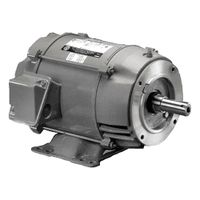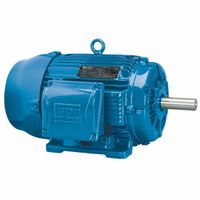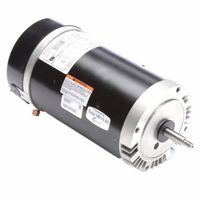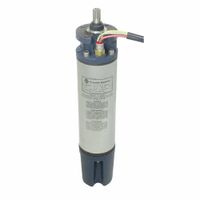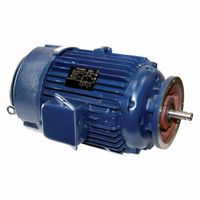Call +(254) 703 030 000 / 751 483 999 / 721 704 777
.....Read More
Frequently Asked Questions
What is the difference between a pump AC motor and a regular AC motor?
A pump AC motor and a regular AC motor primarily differ in their design, application, and operational characteristics.
1. **Design and Construction**: Pump AC motors are specifically designed to drive pumps, which often require high starting torque and the ability to handle varying loads. They may have features like a robust frame, sealed bearings, and corrosion-resistant materials to withstand the environmental conditions typical in pumping applications. Regular AC motors, on the other hand, are designed for a broader range of applications and may not have these specialized features.
2. **Performance Characteristics**: Pump AC motors are optimized for the torque-speed characteristics required by pumps. They often have a higher starting torque to overcome the initial resistance of the pump and maintain efficient operation under varying load conditions. Regular AC motors may not provide the same level of starting torque and may be optimized for applications with more consistent load demands.
3. **Cooling and Ventilation**: Pump AC motors may have enhanced cooling systems to handle the heat generated during continuous operation, especially in demanding environments. This can include features like external fans or improved ventilation designs. Regular AC motors may have standard cooling systems suitable for less demanding applications.
4. **Efficiency and Energy Consumption**: Pump AC motors are often designed to be more energy-efficient in pump applications, potentially incorporating variable frequency drives (VFDs) to adjust motor speed and reduce energy consumption. Regular AC motors may not have these features unless specifically designed for energy efficiency.
5. **Application-Specific Features**: Pump AC motors might include features like thermal protection, moisture resistance, and compatibility with specific pump types (centrifugal, submersible, etc.). Regular AC motors are more generic and may not include these specialized features unless specified for a particular application.
How do I choose the right pump motor for my application?
1. **Determine the Application Requirements**: Identify the type of fluid, flow rate, and pressure requirements. Consider the fluid's viscosity, temperature, and any corrosive properties.
2. **Calculate the Total Dynamic Head (TDH)**: This includes the vertical lift, friction losses in the piping, and any additional pressure requirements. Accurate TDH calculation is crucial for selecting the right pump.
3. **Select the Pump Type**: Choose between centrifugal, positive displacement, or other specialized pumps based on the fluid characteristics and application needs.
4. **Motor Power Requirements**: Calculate the required horsepower (HP) or kilowatts (kW) using the formula: Power = (Flow rate x Total Dynamic Head x Specific Gravity) / (3960 x Pump Efficiency) for HP, or adjust for kW. Ensure the motor can handle the calculated power.
5. **Motor Speed and Efficiency**: Match the motor speed with the pump's operational speed. Consider high-efficiency motors to reduce energy consumption and operational costs.
6. **Voltage and Phase**: Ensure the motor's voltage and phase (single or three-phase) match the available power supply.
7. **Environmental Conditions**: Consider the installation environment. Choose a motor with appropriate enclosure ratings (e.g., TEFC, ODP) for protection against dust, moisture, or explosive atmospheres.
8. **Control and Starting Method**: Decide on direct-on-line, star-delta, or variable frequency drive (VFD) based on the application and starting torque requirements.
9. **Budget and Maintenance**: Balance initial costs with long-term maintenance and operational expenses. Opt for reliable brands with good service support.
10. **Consult with Experts**: Engage with pump and motor manufacturers or consultants to validate your selection and ensure compatibility with your application.
What maintenance is required for pump AC motors?
Maintenance of pump AC motors is crucial for ensuring their efficient and reliable operation. Key maintenance tasks include:
1. **Regular Inspection**: Conduct visual inspections to check for signs of wear, corrosion, or damage. Look for oil leaks, unusual noises, or vibrations that may indicate underlying issues.
2. **Cleaning**: Keep the motor and its surroundings clean. Remove dust, dirt, and debris from the motor housing, cooling fins, and air vents to prevent overheating and ensure proper ventilation.
3. **Lubrication**: Regularly lubricate bearings according to the manufacturer's recommendations. Use the correct type and amount of lubricant to prevent friction and wear.
4. **Electrical Connections**: Inspect and tighten all electrical connections. Loose connections can lead to overheating and electrical failures.
5. **Insulation Resistance Testing**: Periodically test the insulation resistance of the motor windings to detect deterioration. Low insulation resistance can lead to short circuits and motor failure.
6. **Alignment and Balancing**: Ensure the motor is properly aligned with the pump to prevent excessive vibration and wear. Check and correct any misalignment or imbalance.
7. **Temperature Monitoring**: Monitor the motor's operating temperature. Overheating can indicate issues such as overloading or inadequate cooling.
8. **Vibration Analysis**: Conduct vibration analysis to detect imbalances, misalignments, or bearing failures. Address any abnormal vibrations promptly.
9. **Load Testing**: Perform load tests to ensure the motor is operating within its rated capacity. Overloading can lead to overheating and premature failure.
10. **Record Keeping**: Maintain detailed records of all maintenance activities, inspections, and repairs. This helps in tracking the motor's performance and planning future maintenance.
By adhering to these maintenance practices, the longevity and efficiency of pump AC motors can be significantly enhanced, reducing downtime and repair costs.
How do I troubleshoot a pump motor that isn't working?
1. **Safety First**: Ensure the power supply is turned off to prevent electrical shock. Use lockout/tagout procedures if necessary.
2. **Visual Inspection**: Check for visible signs of damage or wear, such as burnt wires, loose connections, or physical damage to the motor or pump.
3. **Power Supply**: Verify that the motor is receiving power. Use a multimeter to check voltage at the motor terminals. Ensure the circuit breaker or fuse is not tripped or blown.
4. **Connections**: Inspect electrical connections for tightness and corrosion. Loose or corroded connections can cause voltage drops or intermittent operation.
5. **Overload Protection**: Check if the motor's overload protection has tripped. Reset it if necessary, but investigate the cause of the overload.
6. **Motor Windings**: Use an ohmmeter to test the motor windings for continuity. Open or shorted windings indicate a faulty motor.
7. **Capacitors**: If the motor uses a start or run capacitor, test it with a multimeter. A faulty capacitor can prevent the motor from starting.
8. **Mechanical Issues**: Ensure the pump is not jammed or obstructed. Manually rotate the motor shaft to check for binding or resistance.
9. **Bearings**: Listen for unusual noises that may indicate bearing failure. Check for excessive vibration or heat.
10. **Motor Load**: Ensure the motor is not overloaded. Compare the actual load with the motor's rated capacity.
11. **Environmental Factors**: Check for environmental issues such as moisture, dust, or temperature extremes that may affect motor performance.
12. **Consult Documentation**: Refer to the motor and pump manuals for specific troubleshooting steps and specifications.
13. **Professional Help**: If the issue persists, consult a professional technician for further diagnosis and repair.
What are the energy efficiency considerations for pump AC motors?
Energy efficiency considerations for pump AC motors involve several key factors:
1. **Motor Efficiency**: Selecting high-efficiency motors, such as those meeting IE3 or IE4 standards, reduces energy consumption. These motors have improved design and materials that minimize losses.
2. **Proper Sizing**: Oversized motors operate inefficiently. Ensuring the motor is appropriately sized for the pump's load profile optimizes energy use.
3. **Variable Frequency Drives (VFDs)**: Implementing VFDs allows for speed control, matching motor speed to the pump's demand. This reduces energy use, especially in systems with variable flow requirements.
4. **Power Factor Correction**: Improving the power factor through capacitors or synchronous motors reduces reactive power, enhancing overall system efficiency.
5. **Maintenance**: Regular maintenance, including lubrication, alignment, and cleaning, ensures motors operate efficiently by preventing energy losses due to mechanical issues.
6. **System Design**: Efficient system design, including minimizing pipe friction and optimizing pump selection, reduces the motor's workload, thus saving energy.
7. **Load Management**: Implementing load management strategies, such as demand response, can optimize energy use during peak and off-peak times.
8. **Monitoring and Control Systems**: Advanced monitoring systems can provide real-time data on motor performance, allowing for adjustments that enhance efficiency.
9. **Temperature Management**: Ensuring motors operate within optimal temperature ranges prevents energy losses due to overheating.
10. **Lifecycle Cost Analysis**: Considering the total cost of ownership, including energy costs over the motor's lifespan, can guide the selection of more efficient motors.
By addressing these considerations, energy consumption can be significantly reduced, leading to cost savings and environmental benefits.
How do I determine the correct size of a pump motor for my needs?
To determine the correct size of a pump motor, follow these steps:
1. **Identify the Flow Rate**: Determine the required flow rate (Q) in gallons per minute (GPM) or liters per second (L/s) based on your system's needs.
2. **Determine Total Dynamic Head (TDH)**: Calculate the TDH, which includes the vertical lift (static head), friction losses in pipes and fittings, and any additional pressure requirements. Use the formula:
\[
\text{TDH} = \text{Static Head} + \text{Friction Losses} + \text{Pressure Head}
\]
3. **Select the Pump Type**: Choose a pump type suitable for your application (centrifugal, submersible, etc.) based on the fluid properties and system requirements.
4. **Consult Pump Curves**: Use pump performance curves provided by manufacturers to find a pump that meets your flow rate and TDH. Ensure the pump operates near its Best Efficiency Point (BEP).
5. **Calculate Brake Horsepower (BHP)**: Use the formula:
\[
\text{BHP} = \frac{\text{Q (GPM)} \times \text{TDH (ft)}}{3960 \times \text{Pump Efficiency}}
\]
Adjust units as necessary for metric systems.
6. **Determine Motor Power**: Convert BHP to kilowatts (kW) if needed, and select a motor with a power rating slightly above the calculated BHP to account for inefficiencies and ensure reliability.
7. **Check Motor Compatibility**: Ensure the motor is compatible with the pump's operating conditions, including voltage, phase, and frequency.
8. **Consider Safety Factors**: Apply a safety margin (typically 10-20%) to accommodate variations in operating conditions and potential future system expansions.
9. **Review Environmental Conditions**: Ensure the motor is suitable for the installation environment, considering factors like temperature, humidity, and potential exposure to corrosive substances.
10. **Consult with Experts**: If unsure, consult with pump and motor specialists to verify your selection.
What are the common causes of pump motor failure?
Common causes of pump motor failure include:
1. **Electrical Issues**: Voltage imbalances, phase loss, or power surges can lead to overheating and insulation breakdown. Poor connections and faulty wiring can also cause electrical failures.
2. **Overloading**: Operating a motor beyond its capacity can cause excessive heat, leading to insulation failure and mechanical stress.
3. **Overheating**: Inadequate cooling due to blocked ventilation, high ambient temperatures, or excessive friction can cause the motor to overheat, damaging the windings.
4. **Bearing Failure**: Improper lubrication, misalignment, or contamination can lead to bearing wear and failure, causing increased friction and heat.
5. **Vibration**: Misalignment, imbalance, or loose components can cause excessive vibration, leading to mechanical wear and eventual failure.
6. **Contamination**: Dust, dirt, moisture, or corrosive substances can infiltrate the motor, leading to insulation breakdown and mechanical wear.
7. **Cavitation**: Inadequate suction pressure can cause vapor bubbles to form and collapse, damaging the impeller and other components.
8. **Seal Failure**: Worn or damaged seals can lead to leaks, allowing contaminants to enter and cause damage.
9. **Improper Installation**: Incorrect alignment, mounting, or electrical connections can lead to premature failure.
10. **Lack of Maintenance**: Neglecting regular inspections, cleaning, and servicing can lead to the accumulation of issues that cause failure.
11. **Mechanical Wear**: Normal wear and tear over time can degrade components, leading to failure if not addressed.
12. **Environmental Factors**: Exposure to harsh conditions such as extreme temperatures, humidity, or corrosive environments can accelerate wear and failure.
Addressing these issues through regular maintenance, proper installation, and monitoring can help prevent pump motor failures.


